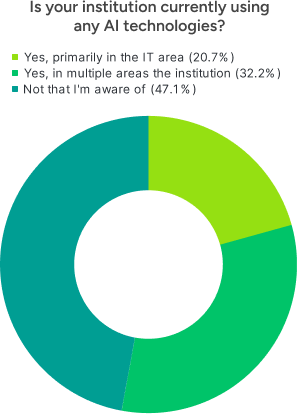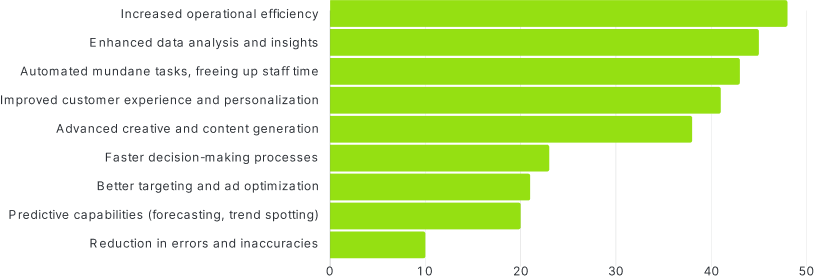Articles and White Papers on AI in Higher Education and Document Verification
While Artificial Intelligence (AI) and large language models are not new technologies, the rapid growth of Generative AI in 2022 and 2023 has led to a surge in interest on this topic. With so many universities facing enrollment challenges, the need for innovation and operational efficiencies has never been greater.

A Few Key Terms
Artificial Intelligence (AI):
The ability of a computer or computer-controlled robot to perform tasks commonly associated with intelligent beings.
Artificial General Intelligence (AGI):
This is what the doomsayers fear. It’s when AI becomes self-aware and capable of operating on its own.
Machine Learning (ML):
A subfield of AI that gives computers the ability to learn without explicitly being programmed. ML processes enormous of data to learn over time but requires human input and feedback.
Deep Learning (DL):
DL is the application of ML to complex problems; however, the machine is also equipped with the ability to learn from its mistakes and assess its own probability of reaching a correct result.
Natural Language Processing (NLP):
NLP gives computers the ability to understand text and spoken words in much the same way human beings can.
Large Language Models (LLMs):
An LLM is a specialized type of AI that has been trained on vast amounts of text to understand existing content and generate original content.
Small Language Models (SLMs):
A small language model (SLM) is a lightweight generative AI model. The label “small” in this context refers to the size of the model’s neural network, the number of parameters the model uses to make a decision, and the volume of data the model is trained on.
AI Usage in Higher Education
At the time this survey was conducted (October 2023), 73.6% of respondents advised they had experimented with AI tools personally, but only 52.9% advised that their institutions were leveraging AI in their day-to-day operations. One month later, at the UPCEA MEMS conference in Portland, Oregon, we asked a similar question of our audience during a panel. Anecdotally, while both personal and professional use of AI tools are increasing, it was apparent that the large majority of higher education professional are now using AI in their day-to-day work. One month later, at the UPCEA MEMS conference in Portland, Oregon, we asked a similar question of our audience during a panel. Anecdotally, while both personal and professional use of AI tools are increasing, it was apparent that the large majority of higher education professional are now using AI in their day-to-day work. Drafting thought starter copy or content (80.6%) and creative concepting (54.8%) were the two most commonly noted use cases for leveraging AI tools. In regards to use of specific AI tools, ChatGPT, Dall-E, Bard, and Canva were the most frequently cited tools.

Investing in AI
Although there is growing usage of AI tools within institutions, only 42.5% of our survey respondents felt confident their institution would be investing in AI over the next 12 months. When asked about investment within their respective departments, only 33.3% of respondents anticipated investing in AI over the next year. For those who do anticipate investing in AI over the next 12 months, improving customer engagementthrough personalization and automation (69%) and enhancing data analytics and market insights (65.5%) were noted as top priorities. In conversations with higher education marketing professionals, many are still in the exploratory phase with AI. Many are testing and leveraging free tools to support improved efficiencies in their day-to-daybut have not determined what tools and processes are the best fit for scalable impact.
Current Challenges
When asked what challenges or barriers they’ve faced or anticipate facing when incorporating AI into institutional operations, the top responses were concerns over data and privacy (55.2%) and lack of understanding or knowledge about AI (49.4%).

The Benefits of AI
As more higher education professionals become comfortable with AI through consumption of newsand experimenting with tools, there is excitement about all the potential ways AI can support their institution. When asked about the main benefits they have seen or expect to see from implementing AI at their institutions, the top responses were increased operational efficiency (55.2%) and enhanced data analytics (51.7%).

Primacy View: Top 5 Current AI Opportunities for Higher Ed
As more higher education professionals become comfortable with AI through consumption of newsand experimenting with tools, there is excitement about all the potential ways AI can support their institution. When asked about the main benefits they have seen or expect to see from implementing AI at their institutions, the top responses were increased operational efficiency (55.2%) and enhanced data analytics (51.7%).

Primacy View: Top 5 Current AI Opportunities for Higher Ed
A Strategic Jumpstart.There are a variety of AI tools can help you more quickly analyze data for insights to make informed decisions. Coupled with a generative AI tool, you can ensure your strategy is sound and includes necessary components.
A Creative Jumpstart.Cited the most frequently amongst our survey respondents, many are using Generative AI to get their creative juices flowing. Whether it’s initial idea generation for ad copy, or to generate imagery, there are so many tools to support marketers in this area.
The Efficiency Creator. It seems we’re all needing to do less with more. Leverage AI for efficient analysis, insights, and idea generation. Streamline mundane tasks, saving time to focus on impactful priorities for your institution.
Personalized Experiences.True 1-to-1 personalization at scale can’t be solved by any specific AI tool overnight (yet!), but many CRMs are introducing generative AI functionality to streamline personalized workflows and content.
Predictive Data and Forecasting.Typically, you still need comprehensive and consistent historical data to maximize ROI from marketing investments. However, new predictive analytics tools continued to be introduced that support utilizing disparate data sets.
Primacy View: Three Things You Can Do Today
Experiment with the Tools. A simple search query: “AI tools for ______” can take you on a path to explore tools that are specific to your needs. Increasing tool usage boosts understanding of AI, instilling confidence to effectively leverage it for institutional support.
Start Working on Policies and Procedures. The use of AI is evolving rapidly. If your institution isn’t already discussing how to address from a policy and procedure perspective, it’s important to get started now.
Develop an AI Action Plan. Acknowledging the power and potential of AI is step one. Other common steps include integrating AI into internal training curriculum and forming a core group passionate about AI and it being used effectively at your institution.

Matt Cyr
VP, Strategic Practices

Hayley Warack
VP, Education